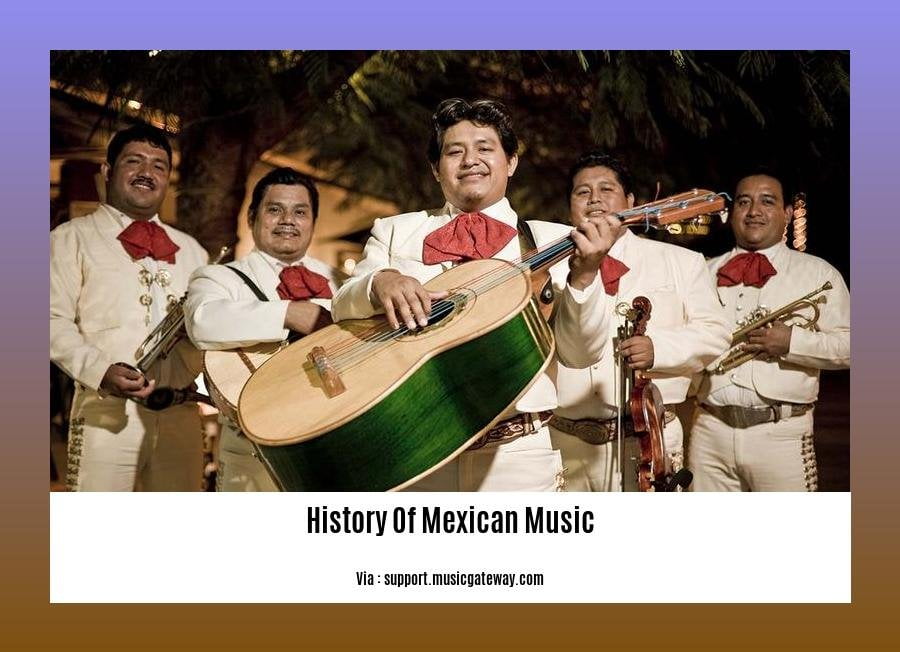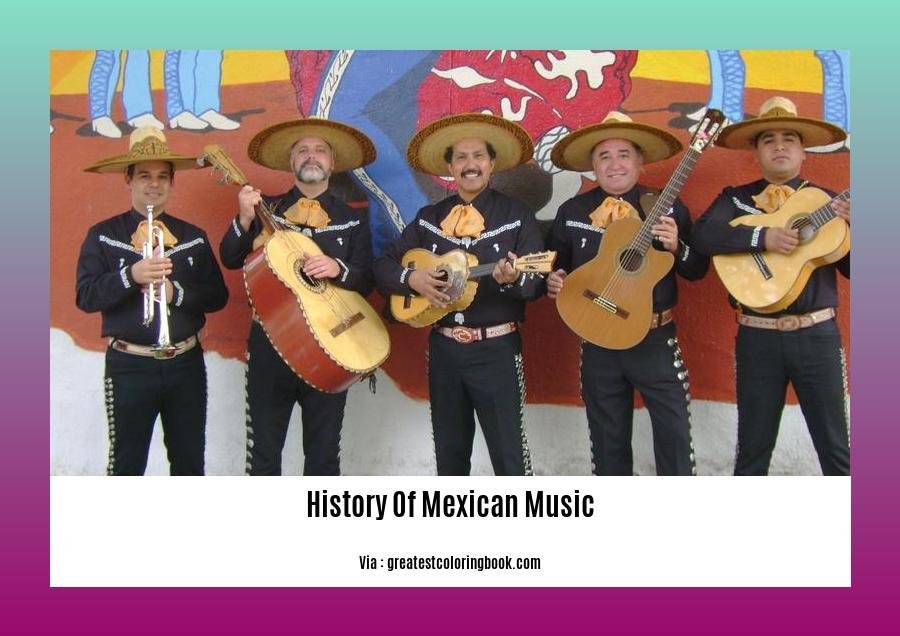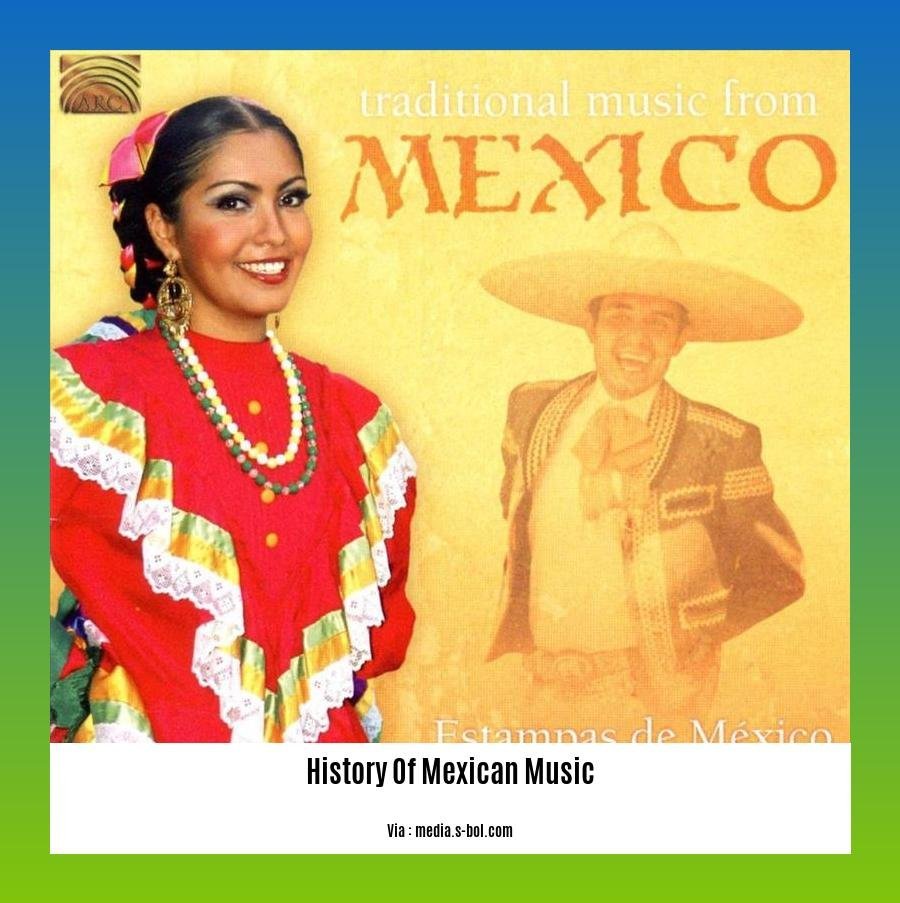Embark on an enchanting journey through the vibrant melodies and rich traditions of Mexican music in our article, “Delving into the Enchanting History of Mexican Music: A Journey Through Rhythms and Traditions.” We’ll explore the captivating fusion of indigenous roots, colonial influences, and contemporary innovations that have shaped this beloved genre.
Key Takeaways:
- Mexican music is incredibly diverse, with various genres influenced by European, Indigenous, Asian, Arab, and Latin American cultures.
- In the nineteenth century, music in Mexico became a way to express Mexican nationalism.
- Ancient Mexican music utilized drums, flutes, rattles, conch shells as trumpets, and voices. Some parts of the country still perform this type of music.
- Traditional contemporary Mexican music was composed during and after the Spanish colonial period using instruments influenced by the old world.
- Popular genres in Mexico include norteño, cumbia, and grupera.
History of Mexican Music

Mexican music’s rich tapestry is a symphony of diverse influences, spanning across cultures and eras. Let’s embark on a journey through its enchanting history!
-
Indigenous Roots:
- Ancient Mexicans crafted instruments from nature’s bounty, utilizing drums, flutes, rattles, conch shells as trumpets, and the human voice.
- These instruments resonated with the rhythms of their daily lives, accompanying rituals, celebrations, and storytelling.
-
European Encounter:
- The arrival of the Spanish in the 16th century marked a turning point.
- They brought with them European musical traditions, instruments, and techniques, which intertwined with indigenous practices.
- This fusion gave birth to new musical genres, blending indigenous melodies with European harmonies and instrumentation.
-
Nationalistic Expressions:
- In the 19th century, Mexican music became a powerful tool for expressing national identity and pride.
- Composers such as Juventino Rosas and Ricardo Castro crafted compositions that resonated with the hearts of Mexicans, evoking a sense of unity and patriotism.
-
Mariachi Magic:
- The mariachi ensemble, with its distinct instrumentation and vibrant attire, emerged as a symbol of Mexican culture.
- Mariachi music, with its infectious rhythms and passionate melodies, became a beloved genre at celebrations and gatherings.
-
Regional Rhythms:
- Mexico’s vast regions boast unique musical traditions that reflect their local heritage.
- Norteño music, with its energetic polkas and corridos, thrives in the northern states.
- Cumbia, with its infectious Afro-Colombian beats, captivates the coastal regions.
- Son jarocho, with its intricate interplay of strings and vocals, echoes in the streets of Veracruz.
- These regional genres showcase the diversity and richness of Mexican music.
-
Modern Soundscapes:
- In recent decades, Mexican music has evolved, embracing contemporary styles and global influences.
- Pop, rock, hip-hop, and electronic music have made their mark, blending with traditional elements to create fresh and innovative sounds.
-
A Living Legacy:
- The history of Mexican music is an ongoing narrative, constantly evolving and adapting to the changing times.
- New genres emerge, traditional forms are reimagined, and Mexican musicians continue to captivate audiences worldwide with their creativity and passion.
-
The Future of Mexican Music:
- The future of Mexican music holds endless possibilities.
- With its deep-rooted traditions and vibrant contemporary scene, Mexican music is poised to continue its journey of innovation and global impact.
- The world eagerly awaits the next chapter in this enchanting musical saga.
-
Discover the fascinating journey of Jamaica from ancient civilizations to modern times through a timeline that unveils the rich history of this Caribbean paradise. history of jamaica timeline
-
Delve into the profound history of the Malankara Orthodox Church, exploring its origins, theological developments, and the significant role it has played in shaping the spiritual landscape of India. history of malankara orthodox church
-
Embark on a colorful exploration of Mexican clothing, tracing its evolution from ancient indigenous traditions to contemporary fashion trends, showcasing the vibrant cultural heritage embedded in every stitch. history of mexican clothing
-
Unravel the captivating story behind the Mexican Hat Dance, a beloved tradition that blends indigenous rituals, Spanish influences, and vibrant choreography, showcasing the rich cultural tapestry of Mexico. history of mexican hat dance
The arrival of the Spanish in the 16th century introduced European instruments and musical forms, which led to the development of new genres such as mariachi and ranchera.
When the Spanish arrived in Mexico in the 16th century, they brought with them a wealth of musical traditions and instruments. These European influences had a profound impact on the development of Mexican music, leading to the creation of new genres such as mariachi and ranchera.
One of the most significant contributions of the Spanish was the introduction of the guitar. The guitar quickly became a popular instrument in Mexico, and it was soon adapted to suit the local musical traditions. The Mexican guitar, or vihuela, is typically smaller than the Spanish guitar and has a higher pitch. It is also often played with a pick, which gives it a brighter sound.
Another important contribution of the Spanish was the introduction of European musical forms, such as the waltz and the polka. These forms were quickly adopted by Mexican musicians, who adapted them to create their unique styles of music. For example, the waltz became the basis for the Mexican danzón, a popular ballroom dance.
The arrival of the Spanish also led to the development of new genres of Mexican music that blended European and indigenous influences. One of the most popular of these genres is mariachi. Mariachi music is typically played by a group of musicians who wear traditional costumes and play a variety of instruments, including the guitar, vihuela, trumpet, and violin. Mariachi music is often associated with celebrations and festivals, and it is a popular choice for serenading loved ones.
Another popular genre of Mexican music that emerged during this time is ranchera. Ranchera music is typically played by a smaller group of musicians, and it is often sung by a solo vocalist. Ranchera songs often tell stories of love, loss, and betrayal, and they are often accompanied by a dramatic dance.
Key Takeaways:
- The arrival of the Spanish in the 16th century introduced several new instruments and musical forms to Mexico.
- The guitar, vihuela, waltz, and polka were among the most significant contributions.
- These European influences led to the development of new genres of Mexican music, such as mariachi and ranchera.
- Mariachi music is typically played by a group of musicians who wear traditional costumes and play a variety of instruments.
- Ranchera music is typically played by a smaller group of musicians and is often sung by a solo vocalist.
Sources:
The History of Mexican Music
The Spanish Influence on Mexican Music
In the 20th Century, Mexican Music Underwent a Period of Modernization and Commercialization, with the Rise of Radio and the Recording Industry.

Imagine yourself transported back in time to the vibrant streets of Mexico in the early 20th century. The airwaves pulsate with the enchanting melodies of mariachi bands, while record stores display the latest vinyl releases featuring ranchera and son jarocho music. This period marked a pivotal transformation in Mexican music, characterized by a fusion of traditional sounds with modern technologies, leading to its widespread commercialization and international recognition.
Radio: The Catalyst for Musical Dissemination
The arrival of the radio in Mexico during the 1920s revolutionized the way people experienced music. Radio stations became the primary medium for broadcasting live performances, allowing musicians to reach a broader audience beyond local communities. Popular radio programs, such as “La Hora Azul” and “El Mundo de los Niños,” showcased a diverse range of Mexican music, contributing to the genre’s growing popularity.
Recording Industry: Preserving and Promoting Mexican Traditions
The development of the recording industry in Mexico paralleled the rise of radio. Record labels, such as RCA Victor and Columbia Records, began to record and distribute Mexican music, enabling artists to share their music with listeners across the country. These recordings not only served as a means of preserving traditional melodies but also facilitated the emergence of new musical styles and the rise of iconic Mexican musicians.
Modernization and Commercialization: A Double-Edged Sword
The modernization and commercialization of Mexican music brought both benefits and challenges. On the one hand, it led to the widespread recognition and appreciation of Mexican music, both within Mexico and internationally. On the other hand, it raised concerns about the potential loss of traditional musical practices and the erosion of regional identities as standardized, commercialized versions of Mexican music gained prominence.
Key Takeaways:
-
The rise of radio in the 1920s provided a platform for musicians to reach a broader audience, contributing to the dissemination of Mexican music throughout the country.
-
The development of the recording industry allowed artists to record and distribute their music, preserving traditional melodies and facilitating the emergence of new musical styles.
-
The modernization and commercialization of Mexican music brought both benefits and challenges, leading to its widespread recognition while raising concerns about the preservation of traditional practices.
References:
Today, Mexican music continues to evolve, with new genres emerging and traditional styles being reinterpreted by contemporary artists.
Contemporary Mexican music is undergoing a remarkable renaissance, characterized by the emergence of novel genres and the reinvigoration of traditional styles by modern musicians. This dynamic musical landscape reflects the vibrant vitality and enduring legacy of Mexican culture.
Key Takeaways:
- Fusion and Innovation: Today’s Mexican music is a harmonious blend of traditional and modern, with artists seamlessly merging diverse genres, instruments, and styles to create captivating new sounds.
- Global Appeal: Mexican music continues to transcend borders, captivating audiences worldwide with its infectious rhythms, poignant lyrics, and captivating melodies.
- New Sounds and Voices: A fresh generation of Mexican artists is pushing musical boundaries, experimenting with diverse influences and fusing traditional elements with contemporary beats to create a uniquely Mexican sound.
- Preserving Tradition: While embracing innovation, Mexican musicians remain committed to preserving the rich heritage of traditional music, ensuring that timeless classics continue to resonate with new generations.
- Multicultural Exchange: Mexican music is an incubator of cultural exchange, with artists collaborating with musicians from around the world, leading to a vibrant fusion of sounds and stories.
Evolving Rhythms and Reimagined Melodies:
- Regional Rhythms Reinvented: Contemporary artists are reimagining regional Mexican genres like Banda, Norteño, and Cumbia, injecting them with modern production techniques and infusing them with elements of other genres.
- Crossover Collaborations: Mexican musicians are embracing collaborations with artists from different genres, such as pop, rock, and hip-hop, resulting in unexpected and captivating musical fusions.
- Global Inspirations: Mexican music continues to embrace global influences, incorporating sounds and rhythms from around the world to create a truly international sonic tapestry.
The Future of Mexican Music:
- Endless Possibilities: The future of Mexican music holds boundless possibilities, with new genres waiting to emerge and traditional styles ready for reinvention, ensuring the genre’s continued evolution and global impact.
- Breaking Language Barriers: Mexican music’s universal appeal transcends language barriers, connecting with listeners from all corners of the world through the power of melody and rhythm.
- A Global Stage: Mexican music’s growing global popularity ensures that it will continue to grace stages worldwide, representing the nation’s rich cultural heritage to international audiences.
Playing a Role in its Evolution:
- Attend Live Shows: Immerse yourself in the magic of Mexican music by attending live performances, supporting local musicians, and experiencing the energy of these captivating events.
- Support Local Artists: Show your appreciation for Mexican musicians by purchasing their albums, attending their concerts, and advocating for their work within your community.
- Share the Sounds: Introduce your friends, family, and social networks to the wonders of Mexican music, sharing playlists, recommending artists, and spreading the love for this vibrant genre.
Sources:
- Spotify Newsroom: A New Generation of Mexican Artists Is Reimagining Traditional Sounds
- El País: A New Chapter in the History of Mexican Music
FAQ
Q1: How did Mexican music evolve throughout history?
A1: Mexican music has undergone significant transformations over the centuries, from its indigenous roots to European influences during the colonial period and the emergence of new genres during the Mexican Revolution. The fusion of various cultural elements has shaped its diverse sounds and rhythms.
Q2: What are the main characteristics of traditional Mexican music?
A2: Traditional Mexican music incorporates instruments like drums, flutes, rattles, conch shells, and voices, which have been used since ancient times. The fusion of indigenous and European musical influences during the colonial era gave rise to unique genres like mariachi, ranchera, and son jarocho, each characterized by distinct melodies, rhythms, and instrumentation.
Q3: How did the Mexican Revolution impact the music scene?
A3: During the Mexican Revolution, music played a crucial role in expressing social and political sentiments. New genres such as corridos and rancheras emerged, capturing the struggles and aspirations of the people. These songs often conveyed revolutionary messages and became anthems for the movement.
Q4: How did the development of the recording industry and radio broadcasting influence Mexican music?
A4: The advent of the recording industry and radio broadcasting in the 20th century played a pivotal role in disseminating Mexican music throughout the country and beyond. It enabled musicians to reach a wider audience, leading to the rise of popular genres like norteño, cumbia, and grupera.
Q5: How is Mexican music evolving in the contemporary era?
A5: In recent decades, Mexican music has witnessed a resurgence with a new generation of artists pushing boundaries and creating unique fusions. The genre is gaining popularity beyond traditional strongholds, reaching new audiences worldwide. Regional Mexican music, encompassing genres like mariachi, banda, and norteño, is gaining global recognition, while crossover artists from other genres are injecting fresh energy into the Mexican music scene.
- Unveiling the Enigma: Mansoureh Khojasteh Bagherzadeh’s Public Appearances & Private Life in Iran - July 18, 2025
- Unveiling the Mystery: Mansoureh Khojasteh Bagherzadeh’s Husband: A Rare Glimpse into a Private Life - July 18, 2025
- Unveiling Masoud Khamenei’s Mother: Power, Influence, and Iran’s Future - July 18, 2025
















